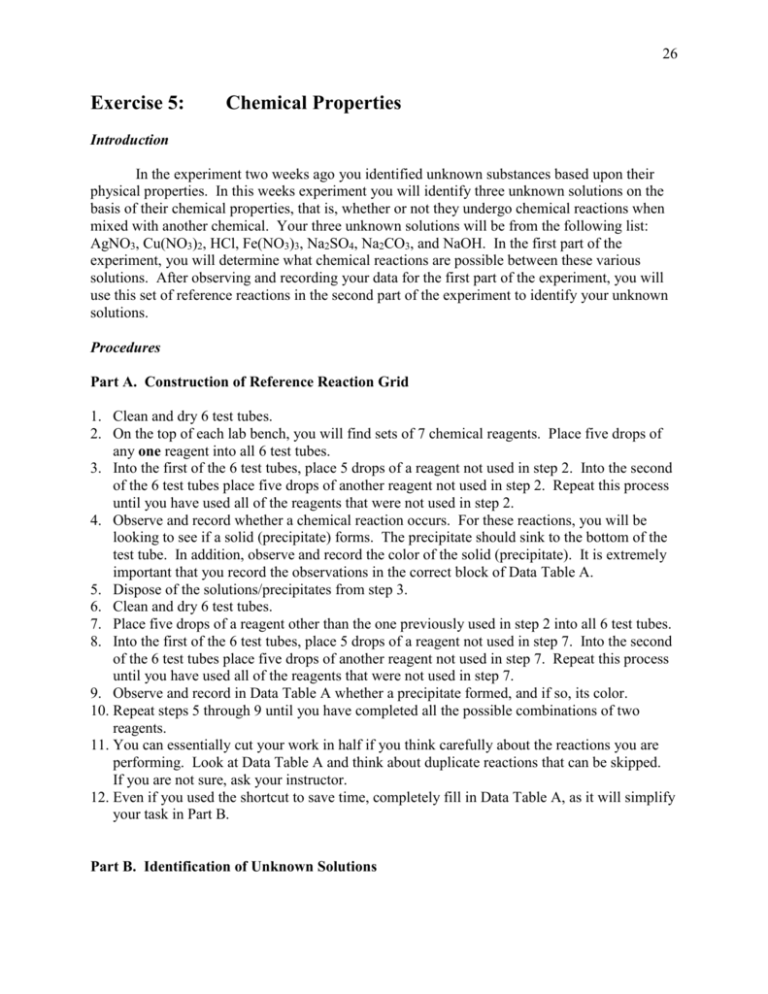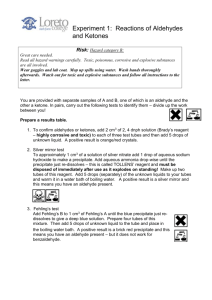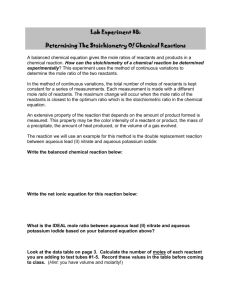Exercise n:
advertisement

26 Exercise 5: Chemical Properties Introduction In the experiment two weeks ago you identified unknown substances based upon their physical properties. In this weeks experiment you will identify three unknown solutions on the basis of their chemical properties, that is, whether or not they undergo chemical reactions when mixed with another chemical. Your three unknown solutions will be from the following list: AgNO3, Cu(NO3)2, HCl, Fe(NO3)3, Na2SO4, Na2CO3, and NaOH. In the first part of the experiment, you will determine what chemical reactions are possible between these various solutions. After observing and recording your data for the first part of the experiment, you will use this set of reference reactions in the second part of the experiment to identify your unknown solutions. Procedures Part A. Construction of Reference Reaction Grid 1. Clean and dry 6 test tubes. 2. On the top of each lab bench, you will find sets of 7 chemical reagents. Place five drops of any one reagent into all 6 test tubes. 3. Into the first of the 6 test tubes, place 5 drops of a reagent not used in step 2. Into the second of the 6 test tubes place five drops of another reagent not used in step 2. Repeat this process until you have used all of the reagents that were not used in step 2. 4. Observe and record whether a chemical reaction occurs. For these reactions, you will be looking to see if a solid (precipitate) forms. The precipitate should sink to the bottom of the test tube. In addition, observe and record the color of the solid (precipitate). It is extremely important that you record the observations in the correct block of Data Table A. 5. Dispose of the solutions/precipitates from step 3. 6. Clean and dry 6 test tubes. 7. Place five drops of a reagent other than the one previously used in step 2 into all 6 test tubes. 8. Into the first of the 6 test tubes, place 5 drops of a reagent not used in step 7. Into the second of the 6 test tubes place five drops of another reagent not used in step 7. Repeat this process until you have used all of the reagents that were not used in step 7. 9. Observe and record in Data Table A whether a precipitate formed, and if so, its color. 10. Repeat steps 5 through 9 until you have completed all the possible combinations of two reagents. 11. You can essentially cut your work in half if you think carefully about the reactions you are performing. Look at Data Table A and think about duplicate reactions that can be skipped. If you are not sure, ask your instructor. 12. Even if you used the shortcut to save time, completely fill in Data Table A, as it will simplify your task in Part B. Part B. Identification of Unknown Solutions 27 1. 2. 3. 4. 5. Obtain your three unknown solutions from your instructor. Record your unknown numbers in Data Table B. Clean and dry 7 test tubes. Place five drops of one of your unknown solutions into all 7 test tubes. Into the first of the 7 test tubes, place 5 drops of one of the known reagents. Into the second of the 7 test tubes place five drops of another known reagent. Repeat this process until you have used all of the known reagents. 6. Observe and record whether a chemical reaction occurs. In addition, observe and record the color of the solid (precipitate). It is extremely important that you record the observations in the correct block of Data Table B. 7. Dispose of the solutions/precipitates from step 5. 8. Clean and dry 7 test tubes. 9. Place five drops of a different unknown solution into all 7 test tubes. 10. Into the first of the 7 test tubes, place 5 drops of one of the known reagents. Into the second of the 7 test tubes place five drops of another known reagent. Repeat this process until you have used all of the known reagents. 11. Observe and record whether a chemical reaction occurs. In addition, observe and record the color of the solid (precipitate). 12. Repeat steps 6 through 10 with your final unknown solution. 13. Dispose of all solutions/precipitates. 14. Compare your results from Part B to Part A. You should be able to identify your unknown solutions by comparing which mixtures produced precipitates and their colors. 15. Record the identity of your unknown solutions. 28 Data Sheet for Exercise 5: Chemical Properties Data Table A. Reference Grid Substance AgNO3 AgNO3 xxxxxxx xxxxxxx Cu(NO3)2 Cu(NO3)2 Fe(NO3)3 Na2SO4 Na2CO3 HCl NaOH xxxxxxx xxxxxxx Fe(NO3)3 xxxxxxx xxxxxxx Na2SO4 xxxxxxx xxxxxxx Na2CO3 xxxxxxx xxxxxxx HCl xxxxxxx xxxxxxx NaOH xxxxxxx xxxxxxx Data Table B. Unknown Identification Substance AgNO3 Cu(NO3)2 Unknown ___ Unknown ___ Unknown ___ Unknown ___ is __________. Unknown ___ is __________. Unknown ___ is __________. Fe(NO3)2 Na2SO4 Na2CO3 HCl NaOH 29 Exercise 5: Chemical Properties, Pre-Lab Questions 1. A student performing a similar experiment found the following results after mixing her known solutions together: a) H2SO4 + Pb(NO3)2 white solid b) Zn(NO3)2 + NH3 white solid c) Zn(NO3)2 + Na2S white solid d) Pb(NO3)2 + NH3 white solid e) Na2S + Pb(NO3)2 black solid Completely fill in the table below: Substance H2SO4 H2SO4 xxxxxxxxxx xxxxxxxxxx Na2S Na2S NH3 Pb(NO3)2 Zn(NO3)2 xxxxxxxxxx xxxxxxxxxx NH3 xxxxxxxxxx xxxxxxxxxx Pb(NO3)2 xxxxxxxxxx xxxxxxxxxx Zn(NO3)2 xxxxxxxxxx xxxxxxxxxx 2. The student found the following results for her two unknown solutions: a) Unknown 1 + Na2S white solid b) Unknown 2 + Pb(NO3)2 white solid c) Unknown 1 + NH3 white solid Completely fill in the table below: Substance H2SO4 Na2S Unknown 1 Unknown 2 3. On the basis of the data in questions 1 and 2: NH3 Pb(NO3)2 Zn(NO3)2 30 Unknown 1 is __________. Unknown 2 is __________.







